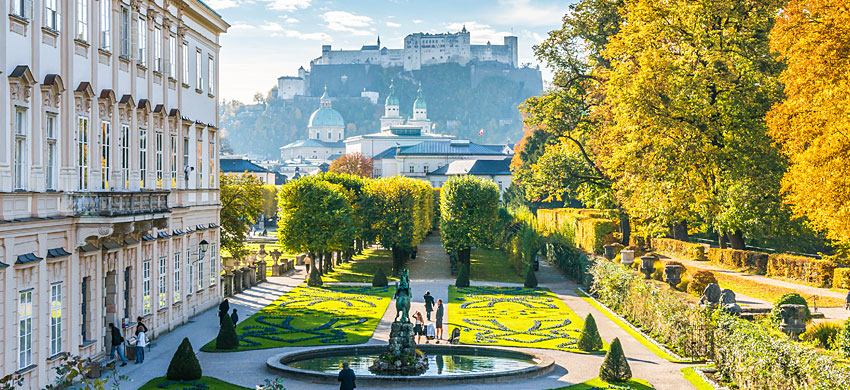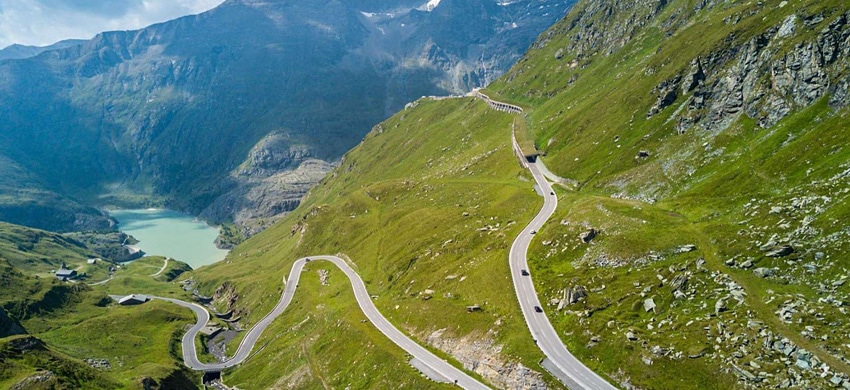

Let yourself be captivated by the Salzburger Land. This beautiful region of Austria, whose capital is unsurprisingly Salzburg, will enchant you with a unique combination of music, art and nature. Everything revolves around Wolfgang Amadeus Mozart, one of the world’s most famous composers, who was born and lived part of his life in Salzburg. A UNESCO World Heritage Site since 1997, Salzburg is undoubtedly one of the most beautiful cities in Europe.
One of them is the Grossglockner Alpine Road, which connects the region with Carinthia over 48 kilometres of spectacle, including meadows, forests, glaciers and Alpine peaks, among which the Grossglockner, which gives its name to the road and is the highest mountain in Austria at almost 3,800 metres.
For active outdoor holidays, the Salzburger Land is the perfect destination. In summer, hikers will find plenty to do in the lakes of the Salzkammergut and the Hohe Tauern National Park, while in winter, Bad Gastein is the most popular destination.
Salzburg is located roughly in the geographical centre of Austria. Part of its western border is shared with the German region of Bavaria, while it shares the rest of its internal borders with Upper Austria, Styria, Carinthia and Tyrol. Finally, for a very small part, just under 10 kilometres, it borders the province of Bolzano (Italy) to the south.
The Salzburger Land is the perfect region for mountain lovers, both in winter and summer. However, its capital city Salzburg will delight all lovers of baroque art and classical music. Here are the most interesting things to visit in this part of Austria.

Of the thousands of things to see in the Salzburger Land, the first is undoubtedly its capital city Salzburg. Austria’s fourth largest city by population, it originated in Roman times and developed further from 700 AD. Today it is a UNESCO World Heritage Site, thanks to its beautiful Romanesque and Gothic churches, Renaissance and Baroque influences, Mozart’s legacy and its magnificent castle, which dominates the city from a hilltop.
Salzburg is a highly tourist-oriented city where, during the high season, visitors outnumber residents. Many of its sights are located in the old town, the Altstadt Salzburg, including the cathedral, the Franciscan church, the Church of the Holy Trinity, the Residenz, the Mirabell Palace and Mozart’s birthplace.
Worthy of special mention is the Hohensalzburg Fortress, Salzburg’s castle on top of the Festungsberg hill. Dating back to 1100, it is one of the largest medieval castles in Europe, 250 metres long and 150 metres wide. The castle can be visited from inside and out, and offers wonderful views of the city.

The town of Bad Gastein is an atypical place in Austria, as it is full of Belle Epoque-style buildings, which is rather strange for an Alpine village. The reason is easily explained: Bad Gastein has been known as a spa town since the 18th century, so much so that ‘Bad’ means spa. Another special feature of Bad Gastein is its enormous waterfall, which cascades down very close to the town centre and is one of its main attractions.
But Bad Gastein is above all a destination for skiers: its ski resort is part of the huge area named Ski Amadè in honour of Mozart, which with 760 kilometres of slopes is one of the largest in Europe. Ski Amadè runs through five unconnected regions: Salzburger Sportwelt, Schladmind-Dachstein, Gastein, Hochkonig and Grossarltal. Each of them contains several ski areas, making a total of no less than 28 ski areas under one label.

The Grossglockner Alpine Road, or Großglockner-Hochalpenstrasse in German, is the highest paved mountain pass in Austria. It connects Bruck, in Salzburg, with Heilingeblut, in Carinthia, passing over the Hochtor Pass at an altitude of an impressive 2504 metres. The road was built from the 1930s onwards and renovated several times throughout its history.
It is usually open from May to October, and a toll must be paid to travel it. It winds its way through the Alps with a series of hairpin bends, viewpoints, tunnels and breathtaking views. There is also a visitor centre, on the Kaiser-Franz-Josefs-Höhe, at an altitude of 2369 metres, and a diversion leading to the Glocknerhaus alpine hut. The Grossglockner alpine road was also the scene of the Giro d’Italia bicycle race twice: in 1971 and 2011.

The Liechtensteinklamm, or Liechtenstein Gorge, is a narrow gorge up to 300 metres deep, located 50 kilometres south of Salzburg. It is about 4 kilometres long and is named after Prince John II of Liechtenstein called the Good, who had the walkways installed in 1875, making it possible to walk through it.
Only one of the 4 kilometres of the Liechtensteinklamm is open to visitors, and only in the summer months. At the end of the gorge, a beautiful waterfall can be admired. According to a curious legend, the gorge was created when the devil, filled with rage because of a plan gone wrong, flew into the canyon and threw water into it, with such force that it carved through the rock.

Among the things to see in the Salzburger Land, we could not fail to mention the Eisriesenwelt, the largest cave in the world. Its name means ‘world of the ice giants’, and it is located south of Salzburg, inside the Hochkogel mountain. The cave stretches over 42 kilometres and is visited by more than 200,000 tourists every year.
Discovered in 1879 by the explorer Anton Posselt, who visited only the first 200 metres, its entrance can be reached by cable car. It is open from 1 May to 26 October each year, and the temperatures inside are below 0 degrees, so appropriate clothing is required. Photography is prohibited inside the cave.
The Eisriesenwelt cave can be visited by taking part in a guided group tour lasting 1 hour and 15 minutes, which starts at the entrance and continues through the Posselt Hall, where a huge stalagmite called Posselt Tower in honour of the explorer who discovered the cave can be seen. Shortly afterwards there is a cross marked on the wall, which represents the maximum limit of Posselt’s expedition. From here onwards, one can admire ice formations up to 25 metres high, reminiscent of the most varied shapes, until reaching the areas known as the Alexander von Mörk cathedral and the ice palace, the latter located at a depth of 400 metres.
In the following map you can see the location of the main places of interest mentioned in this article.

